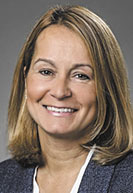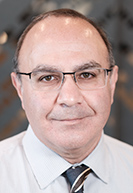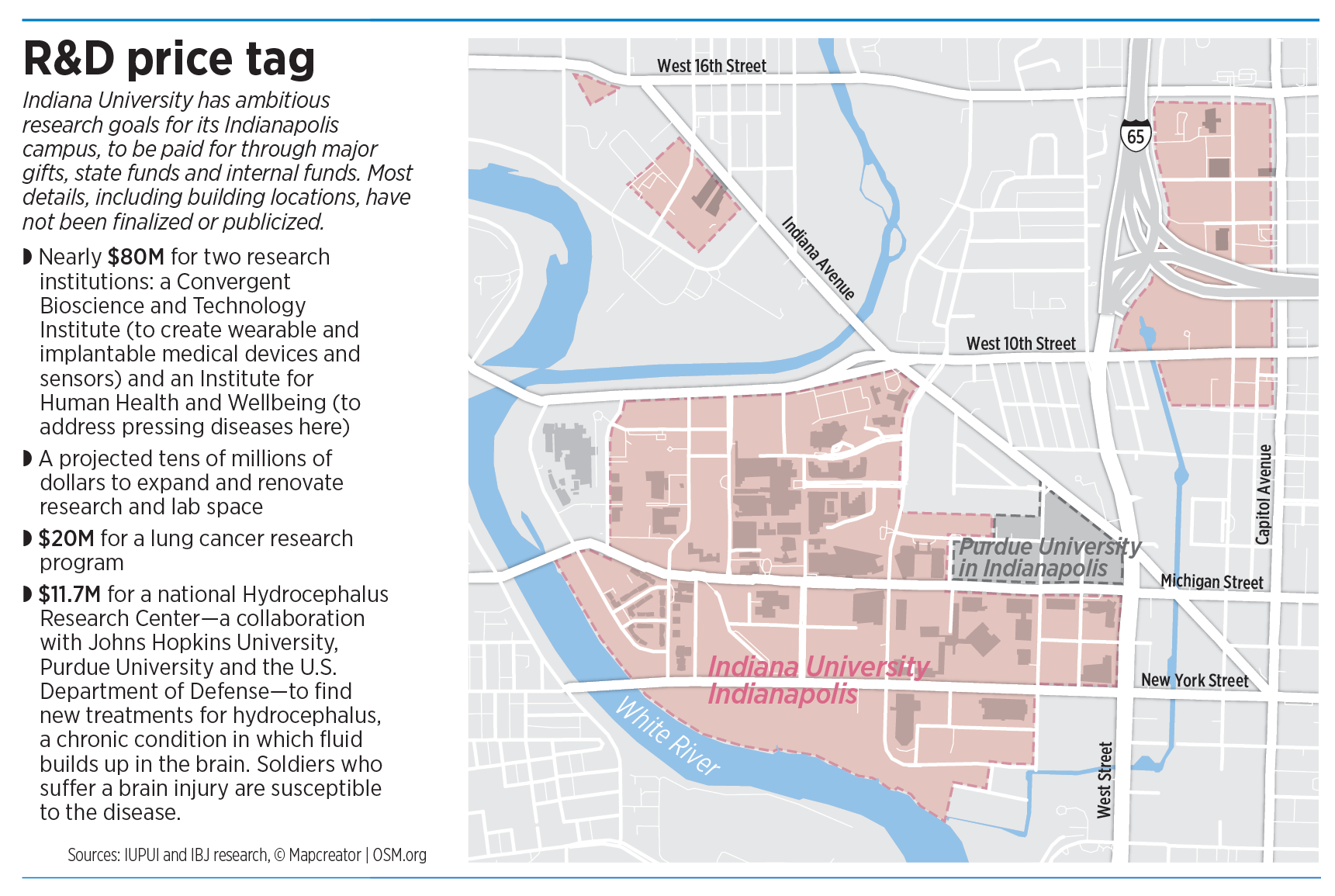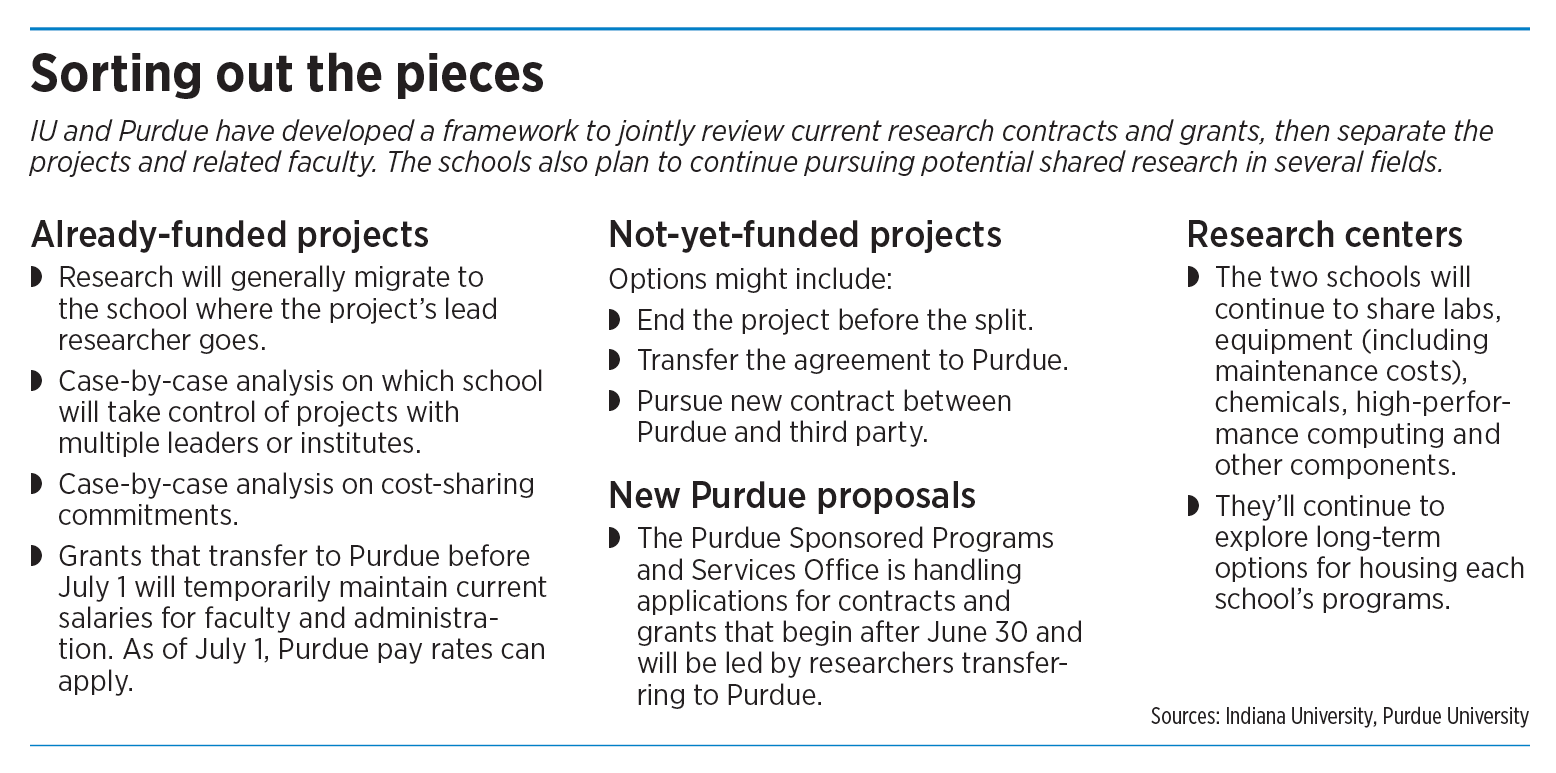Subscriber Benefit
As a subscriber you can listen to articles at work, in the car, or while you work out. Subscribe Now
Indiana University Indianapolis is less than three months from its formal debut on July 1, and the institution’s leaders say they are confident the school will quickly establish itself as a top U.S. urban research university. Some experts caution that the process will take time.

The ambitious goal, which has been touted widely by all sorts of Hoosiers—from campus faculty to IU President Pamela Whitten and Gov. Eric Holcomb—is really a two-part process.
Part 1 won’t involve any effort on the part of IU Indianapolis. The ranking system used to categorize research universities is changing in a way that will move the school into the highest tier. Part 2—building the university’s reputation as a research powerhouse—will be tough but is a goal experts told IBJ is within reach.
Efforts are already underway. Since the presidents of IU and Purdue University announced in 2022 that IUPUI would split into separate operations, the state and IU have announced plans for more than $100 million in research endeavors at IU Indianapolis.
That includes building two science and health research institutes, expanded and renovated research and laboratory space, and up to $10 million for additional faculty. The university also announced plans to double enrollment at the Luddy School of Informatics, Computing and Engineering to increase research output there.
“We are the flagship for the state of Indiana, and with that we take very seriously our responsibility to our state,” Whitten told IBJ.
“That certainly includes being a place that provides an amazing education for our students, but it also means being a place that works in collaboration with all kinds of constituencies to create the workforce that Indiana needs,” she said. “And it means we’re doing research, development and innovation to start industry here, bring industry here and retain companies that are already here.”
The goal is to elevate not just the university but the city. To get there, Indianapolis will have to compete with the likes of Atlanta, Baltimore, Boston, Chicago, Los Angeles and San Diego, each of which are home to robust research institutions that bring in hundreds of millions of dollars a year in federal grants.
And IU Indianapolis will also have to ensure it is meeting thresholds and standards established to distinguish top-flight research schools while collaborating closely with private industry and public partners.
IUPUI is rated a Research 2, or R2, institution by the Carnegie Classification of Institutions of Higher Education, an organization that categorizes more than 4,000 U.S. colleges and universities based on achievement in academics and research.
The status makes Indianapolis one of the few large cities in the United States without a top research institution—classified as R1, for very high research activity.
That ranking system is getting a drastic overhaul heading into 2025 as Carnegie moves away from what some say is a murky formula that relies on 10 factors measuring various aspects of research success to a simplified model that generally boils down to two benchmarks: amount of annual research spending and number of doctoral research graduates.
IUPUI already comfortably meets the new R1 thresholds of at least $50 million a year spent on research and at least 70 annual doctoral research graduates. So Indiana University Indianapolis is poised to be reclassified as R1 when a new list is issued next year.
In IUPUI’s 2023 fiscal year—which ran from July 1, 2022, to June 30, 2023—research spending totaled nearly $89 million, with nearly half of that coming from federal government agencies like the National Institutes of Health.
Of the university’s 3,800 doctoral students, 835 are enrolled in specific research-intensive degree programs. Many others, university officials said, also participate in research tied to their studies.
First steps
A ranking upgrade will be important for IU Indianapolis because many mid- and late-career researchers pursue R1 schools exclusively, particularly those where they can be assured of solid funding, experts said. In many cases, federal grants and contracts are given to schools with top-of-class researchers and a track record in a specific field.
The university also intends to invest heavily in brick and mortar.
It has received a $60 million commitment from the Indiana General Assembly for overhauls and expansions to research facilities, and last October, IU said it’s planning to spend nearly $80 million to build the Convergent Bioscience and Technology Institute and the Institute for Human Health and Wellbeing.
The first is designed to pursue discoveries, with industry partners, in the fields of biomarker detection and wearable and implantable medical devices and sensors. The second is intended to seek solutions for Indianapolis’ most pressing chronic diseases.
“The key here behind both of those entities is that they are at the intersection of life sciences and technology, and that is the space that we’re working in,” said Phaedra Corso, IUPUI associate vice president and vice chancellor for research. “We’re thinking about what we see in the future, 10 years out, and, ‘How do we bring in experts, recruit faculty to these areas to complement what everyone else has already been doing?’”
Corso said the Luddy School will house both institutes, and the university is in the hiring process for directors of each, with the goal of finalizing those positions by early summer.
“That will be our signal to Indianapolis and the state that this is the direction that IUI is going in,” she said. She added that, while Indianapolis has not yet attained the status of a top-tier research university, the applicants for the two positions are “top-notch.”
“If I’m someone who’s interested in life sciences and technology, I want to come to a place where there’s growth potential, and IU Indianapolis has that,” Corso said. “We’ve had no problems [recruiting] so far. … We’re going to really be successful in getting very strong researchers here.”
‘An uphill battle’
The IU School of Medicine is already highly regarded. In 2023, the National Institutes of Health gave it $243 million in research funding—the most in school history and enough to place it among the top 30 medical schools in the United States for research. That and other investments being made in IU Indianapolis could serve as a springboard for further sizable investments and grants for the Indianapolis campus.

Dennis Trinkle, senior vice president of talent, strategy and partnerships at TechPoint, an organization under the umbrella of the Central Indiana Corporate Partnership that supports the state’s tech industry, said TechPoint aims to establish central Indiana as a top 10 U.S. technology hub. All the metro areas currently on the top 10 list include an R1 university.
Trinkle said attracting talent to the university’s research programs has been “an uphill battle,” aside from the medical school and the Luddy school. Not being R1 is “one of the things that’s held us back” as a technology hub and leader in sciences, he said.
“Now, by getting that designation, the university is going to have the ability to lean into that in the same ways they have with the medical school and other areas like Luddy and the Kelley School of Business,” he said. “It is really going to open up that possibility to attract both students at the undergraduate and the graduate level and to attract researchers, along with partnerships and grant dollars.”
Indiana has three R1 research institutions: Indiana University Bloomington, the University of Notre Dame and Purdue University.
“I’m not saying that Indianapolis is going to be the next Silicon Valley, but if you’re doing the research in the right areas,” an institution can take off, said Drumm McNaughton, president of Albuquerque, New Mexico-based higher education consulting firm The Change Leader Inc.
“Take Carnegie Mellon [University], which 25 years ago was a small institution in Pittsburgh,” McNaughton said. “But they had a president who said, ‘We’re going to become one of the top three research universities in [information technology] in the world.’ And since then, they’ve pushed to do that. Who’s to say that Indianapolis can’t do that with its research efforts?”
Industry interests

Vince Wong is CEO of Indianapolis-based BioCrossroads, another organization under CICP’s umbrella; it supports the state’s life sciences industry. He said IU Indianapolis can succeed in making the city a research capital—but it will take time, resources and focus.
“I often get this question of whether Indianapolis can be the next Boston, but my perspective is that we don’t need to be the next Boston or San Diego,” he said.
Instead, Wong said IU Indianapolis should lean into five niches where it is already seeing success: metabolic disorders like diabetes and obesity; orthopedic and medical devices; radiopharmaceuticals, which can target specific organs’ tissues and cells; neurodegenerative diseases like Alzheimer’s and Parkinson’s; and contract research and manufacturing, which focuses on helping pharmaceutical companies achieve their goals.
“We already have existing assets to leverage and build upon, and [we can] make ourselves into the epicenter for those growing areas of research and medicine,” Wong said. “That would be in and of itself a worthy objective for IU to be focused on.”
IUPUI’s Corso said IU Indianapolis will pursue many of those areas in coming years.
“If we start with that as our base, then we can say, ‘What does the future of research look like in these areas? What are we missing? And what’s the next step?’” she said.

Melina Kennedy, CEO of the Central Indiana Corporate Partnership, said IU Indianapolis will be “ripe” for more research opportunities and can further its cause by building partnerships and capitalizing on its proximity to the 16 Tech Innovation District, which sits across Fall Creek from campus.
IU Indianapolis won’t be the only college in the city expanding its research efforts. Purdue University plans to make its Indianapolis operations an extension of its main West Lafayette campus, instead of creating a separate Purdue branch in Indianapolis. That will extend Purdue’s R1 research status to Indianapolis.
“There’s a lot of reasons to be very bullish and optimistic here in Indianapolis about the future of research, with the presence of IU Indianapolis and the Purdue extension as well,” Kennedy said. “The split is really an incredible step in the direction of even more recognition, talent attraction, research and innovation right here. It’s really an exciting time.”

The Indiana Biosciences Research Institute, headquartered at 16 Tech, expects to partner with IU Indianapolis on projects. Even so, leaders said building up the school’s research infrastructure to make it competitive in certain areas could take a while.
“I believe this ambitious goal is truly possible; however, it will take several years and unwavering leadership and resource commitment to make it happen,” Alan Palkowitz told IBJ in emailed comments.
Palkowitz, who joined IBRI in 2020 after more than 30 years in pharmaceutical discovery and development, said the school’s research success will depend on its willingness to embrace the city’s “evolving research and entrepreneurial environment” as well as partnerships outside the educational ecosystem.
He said the institute envisions “significant opportunity for expanded scientific collaboration” and potential commercialization with IU Indianapolis.

Multiple opportunities
As part of an effort to help IU Indianapolis forge research relationships with private industry, the Indy Chamber plans to take a group from the school with it to Boston in September. The chamber each year hosts a visit by Indianapolis government and business leaders to a city where it can exchange ideas with local leaders.

Chamber CEO Matt Mindrum said the decision was inspired by the success of institutions like the Massachusetts Institute of Technology and Harvard University.
“I think a lot of folks think that Boston has been successful in the life sciences and tech and venture capital just because they’re Boston, and because they’ve been there for 400 years, and they’re on the coast,” he said. “But the reality is, there were a lot of intentional investments by the government and industry to make the most of university research investments. We want to see what we can learn from that, because there’s no reason to believe that we can’t have similar impacts here in Indianapolis.”
(IBJ Media CEO Nate Feltman, who is also IBJ’s publisher, plans to be part of Indy Chamber’s delegation to Boston.)
Mindrum said while Indianapolis already has a strong base of research-oriented companies and organizations—including Eli Lilly and Co., Elanco Animal Health Inc., Roche Diagnostics, Corteva Agriscience and the Regenstrief Institute—bringing more federal and private investment to the city through research growth at IU Indianapolis could pay major dividends for the state’s economic development.

Mindrum said that, because Indianapolis hasn’t had an R1 institution, it is “not thought of as a leader, as fertile grounds for new investments” in research and development. But he said IU Indianapolis’ planned research investments here will help.
Indiana Secretary of Commerce David Rosenberg said when residents look back 20 years from now, the split and subsequent increase in focus on research by both IU Indianapolis and Purdue will be “one of the biggest drivers of economic growth for central Indiana and the state as a whole.
“If you put two established, well-recognized R1 universities together in that ecosystem,” he said, it’s “going to lead to huge commercialization and in turn translate to more talent and additional research dollars.”•
Please enable JavaScript to view this content.




“To get there, Indianapolis will have to compete with the likes of Atlanta, Baltimore, Boston, Chicago, Los Angeles and San Diego, each of which are home to robust research institutions that bring in hundreds of millions of dollars a year in federal grants.”
Yeah, IU already gets the vast majority of its federal research funding in Indianapolis. IUSM does the bulk of it, but IUI proper is serious too.
Indiana needs to build a high speed rail to connect all its institutions, universities, tech campuses, research labs ect. From Indy to Bloomington, Purdue, Notre Dame and even Ft Wayne since it’s the second largest city in the state. Connecting all this talent and all roads lead back to Indy would be a game changer for the entire state.
A train line from Indy to the South Shore Line would effectively connect Indy to Purdue & Notre Dame.
Developing a top tier 1 research program is vital for Indianapolis
and growing I.U. In Indianapolis.
Quality of life issues for graduate and doctoral students must
be addressed. Such as more retailing, cafes, bars, and entertainment
spots.
***I talk to many doctoral students daily doing research at IU Med.
They constantly point out Boston, Houston, San Diego, and Austin as
more desirable places to move to upon completing their work
In Indianapolis.*****
Let’s grow I U and Purdue Indianapolis in students and quality of
life. The city should strive to grow the student population here to
40,000 or more through quality of life initiatives.
The state of Indiana is the appropriate source of revenue to properly fund a new major university. The city is budget and revenue limited.